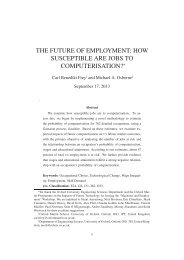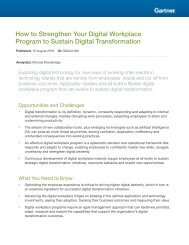THE FUTURE OF EMPLOYMENT: HOW SUSCEPTIBLE ARE JOBS TO COMPUTERIZATION?
We examine how susceptible jobs are to computerization. To assess this, we begin by implementing a novel methodology to estimate the probability of computerization for 702 detailed occupations, using a Gaussian process classifier. Based on these estimates, we examine expected impacts of future computerization on US labor market outcomes, with the primary objective of analyzing the number of jobs at risk and the relationship between an occupation’s probability of computerization, wages and educational attainment. According to our estimates, about 47 percent of total US employment is at risk. We further provide evidence that wages and educational attainment exhibit a strong negative relationship with an occupation’s probability of computerization.
We examine how susceptible jobs are to computerization. To assess this, we begin by implementing a novel methodology to estimate the probability of computerization for 702 detailed occupations, using a Gaussian process classifier. Based on these estimates, we examine expected impacts of future computerization on US labor market outcomes, with the primary objective of analyzing the number of jobs at risk and the relationship between an occupation’s probability of computerization, wages and educational attainment. According to our estimates, about 47 percent of total US employment is at risk. We further provide evidence that wages and educational attainment exhibit a strong negative relationship with an occupation’s probability of computerization.
Create successful ePaper yourself
Turn your PDF publications into a flip-book with our unique Google optimized e-Paper software.
aises questions about: (a) the ability of human labour to win the race against<br />
technology by means of education; and (b) the potential extent of technological<br />
unemployment, as an increasing pace of technological progress will cause<br />
higher job turnover, resulting in a higher natural rate of unemployment (Lucas<br />
and Prescott, 1974; Davis and Haltiwanger, 1992; Pissarides, 2000). While the<br />
present study is limited to examining the destruction effect of technology, it<br />
nevertheless provides a useful indication of the job growth required to counterbalance<br />
the jobs at risk over the next decades.<br />
III.<br />
<strong>THE</strong> TECHNOLOGICAL REVOLUTIONS <strong>OF</strong> <strong>THE</strong> TWENTY-FIRST CENTURY<br />
The secular price decline in the real cost of computing has created vast economic<br />
incentives for employers to substitute labour for computer capital. 15 Yet<br />
the tasks computers are able to perform ultimately depend upon the ability of<br />
a programmer to write a set of procedures or rules that appropriately direct the<br />
technology in each possible contingency. Computers will therefore be relatively<br />
productive to human labour when a problem can be specified – in the sense that<br />
the criteria for success are quantifiable and can readily be evaluated (Acemoglu<br />
and Autor, 2011). The extent of job computerisation will thus be determined<br />
by technological advances that allow engineering problems to be sufficiently<br />
specified, which sets the boundaries for the scope of computerisation. In this<br />
section, we examine the extent of tasks computer-controlled equipment can be<br />
expected to perform over the next decades. Doing so, we focus on advances<br />
in fields related to Machine Learning (ML), including Data Mining, Machine<br />
Vision, Computational Statistics and other sub-fields of Artificial Intelligence<br />
(AI), in which efforts are explicitly dedicated to the development of algorithms<br />
that allow cognitive tasks to be automated. In addition, we examine the application<br />
of ML technologies in Mobile Robotics (MR), and thus the extent of<br />
computerisation in manual tasks.<br />
Our analysis builds on the task categorisation of Autor, et al. (2003), which<br />
distinguishes between workplace tasks using a two-by-two matrix, with routine<br />
versus non-routine tasks on one axis, and manual versus cognitive tasks on the<br />
other. In short, routine tasks are defined as tasks that follow explicit rules that<br />
15 We refer to computer capital as accumulated computers and computer-controlled equipment<br />
by means of capital deepening.<br />
14





